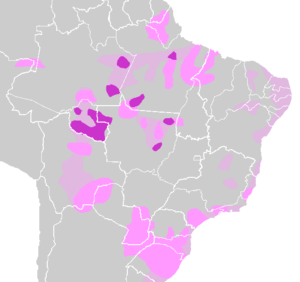Proto-Tupian language
| Tupian | |
|---|---|
| Ethnicity | Tupí |
| Geographic distribution | Brazil, Bolivia, Paraguay, Uruguay, and North-East Argentina |
| Linguistic classification |
Je–Tupi–Carib?
|
| Proto-language | Proto-Tupian |
| Subdivisions | |
| ISO 639-2 / 5 | tup |
| Glottolog | tupi1275[1] |
 Tupi–Guarani (medium pink), other Tupian (violet), and probable range ca. 1500 (pink-grey) | |
Proto-Tupian (PT) is the linguistic reconstruction of the common ancestor of all the Tupian languages. It consists, therefore, of a hypothetic language, reconstructed by the comparative method from data of the descendant languages. In Brazil, the historical-comparative studies are being developed mainly by two scientific teams: one from the Laboratório de Línguas Indígenas (LALI) of the University of Brasília, under the coordination of Aryon Rodrigues; and the other one from the Museu Paraense Emílio Goeldi, located in Belém, under the orientation of Denny Moore. The studies are showing several important evidences about the Proto-Tupi culture (demonstrating, for example, that the ancestors of the Tupi peoples already dedicated to agriculture) [2]
The most accepted theory is that the Tupian language family was originated between the Guaporé and Aripuanã rivers, in the Madeira River basin. Right now, there are almost 70 living Tupian languages, including Tupi, Paraguayan Guarani, Awetï, Ayvu, etc.
Homeland and urheimat
Rodrigues (2007) considers the Proto-Tupian urheimat to be somewhere between the Guaporé and Aripuanã rivers, in the Madeira River basin. Much of this area corresponds to the modern-day state of Rondônia, Brazil. 5 of the 10 Tupian branches are found in this area, as well as some Tupi–Guarani languages (especially Kawahíb), making it the probable urheimat of these languages and maybe of its speaking peoples. Rodrigues believes that PT dates back to around 5,000 B.P.
See also
References
- ↑ Hammarström, Harald; Forkel, Robert; Haspelmath, Martin, eds. (2017). "Tupian". Glottolog 3.0. Jena, Germany: Max Planck Institute for the Science of Human History.
- ↑ Rodrigues, Aryon dall'Agna & Ana Suelly Arruda Câmara Cabral. Investigando a origem e o desenvolvimento de orações dependentes nas famílias do tronco lingüístico Tupi. Revista da Abralin, volume 5, numbers 1 and 2 (ten/2006)
Further reading
- Lyle Campbell (21 September 2000). American Indian Languages: The Historical Linguistics of Native America. Oxford University Press. pp. 199, 201. ISBN 978-0-19-534983-2.
- Spike Gildea (1998). On Reconstructing Grammar: Comparative Cariban Morphosyntax. Oxford University Press. pp. 5, 53, 86, 88. ISBN 978-0-19-510952-8.
- Rik van Gijn; Jeremy Hammond (15 October 2016). Switch Reference 2.0. Typological Studies in Language. John Benjamins Publishing Company. pp. 15–16. ISBN 978-90-272-6677-4.
- Rodrigues, Aryon Dall'Igna (2007). "As consoantes do Proto-Tupí". In Ana Suelly Arruda Câmara Cabral, Aryon Dall'Igna Rodrigues (eds). Linguas e culturas Tupi, p. 167-203. Campinas: Curt Nimuendaju; Brasília: LALI.